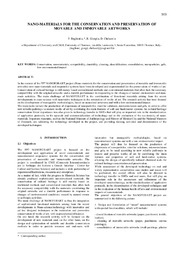| dc.contributor.author | Baglioni, P. | en |
| dc.contributor.author | Giorgi, R. | en |
| dc.contributor.author | Chelazzi, D. | en |
| dc.date.accessioned | 2013-02-15T06:34:45Z | en |
| dc.date.available | 2013-02-15T06:34:45Z | en |
| dc.date.issued | 2012-10-29 | en |
| dc.identifier.issn | 2047-4970 (Print) | en |
| dc.identifier.uri | http://hdl.handle.net/10797/6114 | en |
| dc.description.abstract | In the context of the FP7 NANOFORART project (Nano-materials for the conservation and preservation of movable and immovable artworks) new nano-materials and responsive systems have been developed and experimented for the preservation of works of art. Conservation of cultural heritage is still mainly based on traditional methods and conventional materials that often lack the necessary compatibility with the original artworks and a durable performance in responding to the changes of natural environment and manmade activities. The main challenge of NANOFORART is the combination of functional materials arising from the recent developments in nano-science with innovative techniques in the restoration of works of art. The research activity has been focused on the development of manageable methodologies, based on nanosized structures and with a low environmental impact. The main tasks include the production of dispersions of nanoparticles, micellar solutions, microemulsions and gels, in order to offer new reliable pathways to restore works of art by combining the main features of soft and hard-matter systems for cultural heritage conservation. Great importance was also given to technology transfer to SMEs that will play an important role in the standardization of applicative protocols, in the up-scale and commercialization of technology and in the evaluation of the eco-toxicity of nano-materials. Important museums, such as the National Museum of Anthropology and History of Mexico City and the National Museum of Denmark, are validating the technology developed in the project, and providing training activities and dissemination of the developed techniques. | en |
| dc.description.sponsorship | Department of Chemistry and CSGI, University of Florence, via della Lastruccia 3, Sesto Fiorentino, 50019 Florence, Italy. | en |
| dc.language.iso | eng | en |
| dc.publisher | Multi Science Publishing | en |
| dc.relation.ispartof | International Journal of Heritage in the Digital Era, Volume 1, Supplement 1, Pages 313-318 | en |
| dc.rights | info:eu-repo/semantics/openAccess | en |
| dc.subject | Conservation | en |
| dc.subject | Nanomaterials | en |
| dc.subject | Compatibility | en |
| dc.subject | Durability | en |
| dc.subject | Cleaning | en |
| dc.subject | Deacidification | en |
| dc.subject | Consolidation | en |
| dc.subject | Nanoparticles | en |
| dc.subject | Gels | en |
| dc.subject | Low environmental impact | en |
| dc.title | Nano-Materials for the Conservation and Preservation of Movable and Immovable Artworks | en |
| dc.type | info:eu-repo/semantics/conferenceObject | en |
| dc.identifier.doi | 10.1260/2047-4970.1.0.313 | en |
